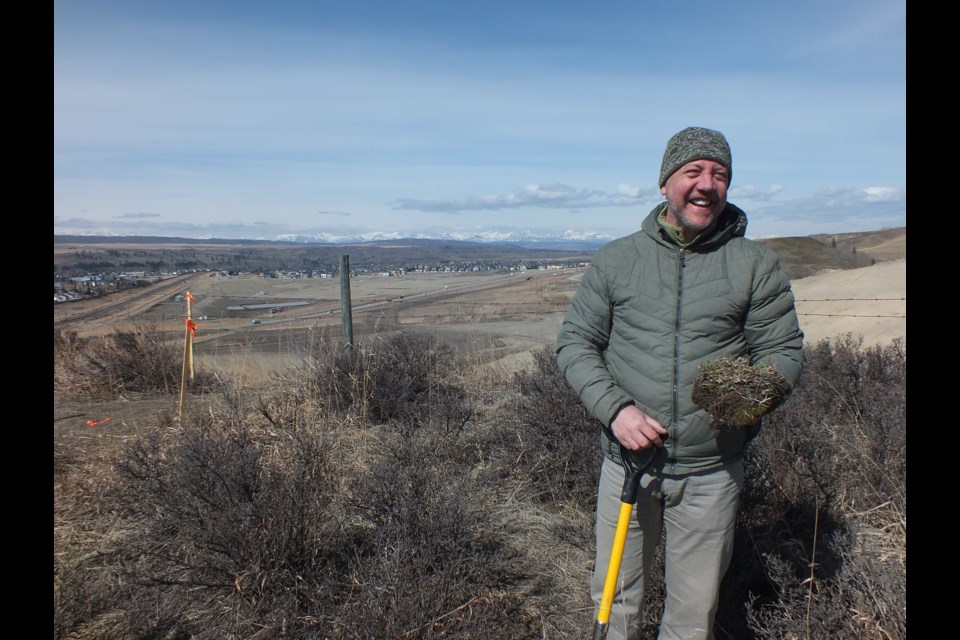It was a perfect sunny day, the kind ideal for roaming around the native grasslands on a hill on the edge of town, looking for crocuses and other rare plants to rescue before the dozer blades scrape away the delicate specimens to build a badly-needed interchange in Cochrane.
And what better date for local nature-loving plant hunters and construction workers to co-exist – maybe even collaborate – than Earth Day?
It took a lot of work (emails, letters, phone calls, texts) and cooperation from multiple government departments and agencies, as well as agreement from more than one construction company last summer to finally secure permission for a group of native Alberta plant enthusiasts to access the hill adjacent to the Men of Vision statue and dig up samples of ancient native species that would otherwise be destined for the dozer’s blade.
And this last ditch effort to retrieve as many plants as they could fit in their buckets and bags on April 22 was exactly that – the last chance before the diesel engines start up again and the scrapers and dozers and trucks begin moving dirt in a big way, as crews work toward the completion of a new interchange at the intersection of highways 1A and 22.
Blake McNeill organizes an active Facebook group that shares information about native grasses and wildflowers. Last summer, he spearheaded the effort to salvage some pristine, mature plant specimens from the south-facing hillside, and was pleased to learn his group would be allowed one last access day this spring.
More than just being allowed, he was blown away by the cooperation of the construction workers (onsite setting up their summer camp in preparation for getting back to work) who smoothed a roadway with a front-end loader into the dig site, so his group could drive right up close with their shovels. The loader operator did so without being asked.
McNeill said the Broda construction group and Ellis Don deserved everyone’s thanks for their efforts.
The mature plants are valuable because they are established. Growing them from seed is a struggle and does not produce plants with the same vigour.
For Stephan Doutre, who could see his house in Heartland from the hilltop on April 22, it was a perfect day for hunting rare native plants.
“It’s like Easter egg hunting for adults – it’s so exciting, looking for treasure,” he said. “And if I’m not here today, this is going to be lost forever.”
He was offered another choice of outdoor activity in the hills on what was a beautiful spring day in Cochrane, but declined in favour of his treasure hunt. He will add his finds to his flower bed at home.
“My wife asked me if I wanted to go skiing – I chose to come here,” he said with a laugh.
Doutre said his choice of activities was just as exciting as his wife’s.
Mathis Natvik is a professor of landscape architecture at the University of Calgary and a grassland specialist. He is also involved in a native grassland restoration project on two acres of land at the U of C campus, where the goal is to re-create native grasslands. Many of the 450-plus plants he’s salvaged will go there, in addition to his own flower beds.
He said the prairie crocus was the main target of most of the shovels on Earth Day.
“These are plants you can’t find at the garden centre – the ones that do have crocuses are just little plugs really, and they take many years just to get to blooming size. Some of the big plants we got last year had 15 to 20 flowers on them,” he said, holding out his latest transplant.
“These plants are as old as a human being, they’re senior citizens.”
The prairie crocus is especially Alberta hardy, able to withstand bitter cold even after it’s started blooming.
“These [flowers] love it out here. If it went to minus 20 right now, the flower just lays down and when it warms up, it pops right back up again,” Natvik said. “They’re adapted to our moody springs.”
Under the headline Ancient Grassland to be Destroyed, he identified 21 species of native wildflowers and four native grasses on the Facebook site.
“Mature grasslands originated about 9,000 years ago and it can’t be replaced – that kind of diversity takes 6,000 years to mature,” he said. “Even though this is a grassland, it’s very much like an old-growth forest.”
Volunteers have rescued thousands of plants from the site and placed them in restoration projects and gardens all over Alberta.
Natvik said he thinks the Cochrane initiative might be the most successful native plant rescue ever in Alberta.
As Natvik spoke, other plant gatherers listened in as they scanned the ground for likely suspects.
He toed a clump of Foothills Rough Fescue grass with his boot, calling it an “indicator species” that was high in nutrients, which made it a favoured target of cattle.
Like Doutre, Natvik said he also turned down a last day of skiing to add to his plant collection.




